|
|
 |
==Images and maps: Links to
a great many miniature paintings, etc. from the period:
*Columbia Univ.*. Links to period
maps from Columbia: *1700-50* and *1750-1800*. |
 |
==After Aurangzeb: Aurangzeb
dies in 1707, still in the Deccan, vainly pursuing the
Marathas. After a series of chaotic succession
struggles, Muhammad Shah (1719-48) has a long and
increasingly ineffectual reign. The Mughal throne
gradually becomes a source of symbolic legitimacy,
rather than a real force in military and political
affairs. Discussion: *Ikram Ch. 19*. Its power becomes
limited first to the area of Delhi, then to the city
itself; the *Imperial Gazetteer* has a great
deal to say about the history of Delhi. (*Routes*) |
 |
==Local rulers and trade networks
thrive: As Mughal power wanes,
local rulers seek to cut their own deals, and Europeans
are eager to get a foothold. The result is a lively and
complex commercial network that includes bazaars,
piracy, raids for loot, military actions, missionary
efforts, and even the sponsorship of religious
festivals. Although there's plenty going on in Bihar (*Anand A. Yang*) and Bengal, the
liveliest action centers on the ports of the Malabar and
Coromandel Coasts. (*Routes*) |
 |
==Bernard Picart
(1673-1733), a French engraver, produces the nine-volume
"Religious Ceremonies and Customs of All the Peoples of
the World" (1722, 1728), which becomes widely
influential throughout Europe; his is just one of a
number of such collections of cultural knowledge. (*Routes*) |
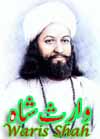 |
==Punjabi poetry makes
itself felt: Bullhe Shah (1680-1758) is, like Kabir,
claimed by both Hindus and Muslims and loved for his
swingy folk poetry (*the south asian*); Waris Shah
(1719-90) creates the most famous retelling of the
mystical folk romance "Hir Ranjha" (*Usborne translation, 1874*; *musical performances*). Waris Shah
also has his own movie, and the lovers Hir and Ranjha
have no fewer than three films to their credit. |
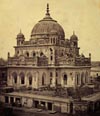 |
==the Navabs of Avadh
(1720-1856): By refusing a transfer to Malwa in 1727,
Mughal governor Burhan ul-Mulk, now Saadat Khan
(r.1720-39), politely establishes his independent power
base. As the first of nine Nawabs of Avadh, he helps
pacify this rich but fractious province in the Gangetic
heartland; under the Navabs, Lucknow and its Shi'a
aristocracy (*J. R. I. Cole*) patronize a
distinctive local culture. The British seize the state
in 1856; the *Imperial Gazetteer* has a good
deal to say about its history. (*Routes*) |
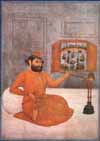 |
==Mir and the Urdu ghazal: Mir
Muhammad Taqi "Mir" (1723-1810) becomes one of the first
creators--and one of the two great masters--of the
preeminent romantic and mystical genre of lyric poetry
in Urdu, the ghazal. Emerging from Persian ghazal, Urdu
ghazal begins at a high level of sophistication, and
remains there until the post-1857 end of the elite
Indo-Muslim cultural world (which includes many Hindus)
that provides its chief patrons. Discussion: *F. W. Pritchett*. Mir spends his
later years in Lucknow after the repeated sacking of
Delhi (*Rosie Llewellyn-Jones*). On Mir's
ghazals: *A Garden of Kashmir*.
|
 |
==the Nizams of Hyderabad
claim their independence (1724): Asaf Jah Nizam al-Mulk,
a Mughal governor of the Deccan, quietly implements the
independence of Hyderabad. The seven Nizams of Hyderabad
rule India's largest princely state, covering most of
the Deccan, until 1948; though over time they are
increasingly under British tutelage. On Hyderabad: *Imperial Gazetteer*; also *My
Life:
being the Autobiography of Nawab Server-ul-Mulk
Bahadur* . (*Routes*) |
 |
==Jaipur and the Jantar Mantars
(c.1725): Raja Savai Jai Singh (*wiki*), an important Mughal
officer, not only founds the city of Jaipur (*wiki*), with its beautiful fort
and palace, but soon equips it with a remarkable
astronomical observatory, the Jantar Mantar (*jantarmantar*)
based
on that of Ulugh Beg in Samarqand (1420) on the *silk road*. He builds a similar
observatory in Delhi as well, and smaller ones
elsewhere. Images of the Delhi one: *Berger*. Images of the Jaipur one:
*google image search*. Discussion:
*art and architecture*; *C. Hartley*. On the history of
Jaipur state: *Imperial Gazetteer*. (*Routes*) |
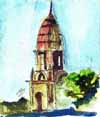 |
==Baji Rao sacks the Delhi suburbs (1738):
Under their new Peshwa, Baji Rao I (1700-40) (*wiki*), the Maratha armies make a
lightning raid on Delhi. They reach, and loot, the
surrounding suburbs (including Talkatora) before
retreating with equal speed. Mughal forces under Saadat
Khan and others are caught off guard and can't react in
time. On the crucial Maratha prince and power-broker
Madhav Rao Sindhia (1730-94): *wiki*; *H. G. Keene, 1891* |
 |
==Nadir Shah sacks Delhi
(1739): The Iranian ruler Nadir Shah (*encyclopedia*; *wiki*) invades India and sacks
Delhi, taking back with him the Peacock Throne (*wiki*), the *Koh-i Nur*
diamond, and 300 artisans. The weakness of the Mughals
is by now clear to everybody. |
 |
==Ahmad Shah Abdali sacks Delhi repeatedly
in a series of raids (1748-61) (*wiki*). He begins as one of Nadir
Shah's officers, and after Nadir Shah's death he becomes
an Afghan tribal ruler in his own right and decides to
continue this highly profitable activity. Although he
doesn't get such astonishing loot, he makes a number of
raids, so that during the middle part of the century
Delhi is never secure, and never really has time to
recover. Finally, he allies himself with Mughal nobles
to defeat the Marathas in the *battle of Panipat, 1761*; *his tomb* |
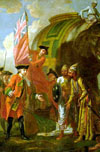 |
== Clive and the Battle of Plassey
(1757): The battle (*wiki*) is, militarily speaking,
nothing much: the East India Company's forces under
Robert Clive, buoyed by earlier victories in Arcot and
elsewhere, defeat Nawab Siraj ad-Daula in a brief
skirmish decided not by force of arms but by a
prearranged deal, as Clive himself reports: *Internet Sourcebook*. But this
foothold opens the way to the battle of Buxar (1764) and
the Company's assumption of the revenue collection (and
governance) for the whole huge province of Bengal
(1772). On this period: *Imperial Gazetteer*; on the whole
colonial history of Bengal: *Imperial Gazetteer*. On Clive's
career: *Macaulay* and *John Malcolm*. Further discussion:
*Sources of Indian Traditions*. (*Routes*) |
 |
==Dean Mahomed (1759-1851),
the first South Asian Muslim to record his own life
story in English, emerges as a remarkable character
whose life spans the cultural divide between North India
(where he fights enthusiastically with the Company's
army) and England (where he later becomes a sort of
massage-physician). For the full story, see Michael
Fisher's edition of Dean Mahomed's letters: *Univ. of California Press*. |
 |
==The first Resident in Avadh
(1772): The Company sends to the court of Navab Shuja
ud-Daulah of Avadh (*wiki*) a "Resident" to represent
its interests. After the Navab's major defeat in the
battle of Buxar, he is unable to refuse. The British
East India Company now begins to surround and
encapsulate the "native states" (*wiki*). |
 |
==Col. Polier and his letters
(1773-79): Col. Antoine Louis Henri Polier (1741-95) is
one of a number of Europeans, especially Frenchmen,
serving at the court of Navab Shuja ud-Daulah and living
very Lakhnavi lives. His Persian letters to his two
wives and many business associates form a unique source
of cultural information. Discussion: *Peter Marshall*. (*Routes*) |
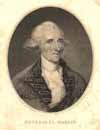 |
==Claude Martin and his schools:
Another Frenchman in Lucknow, Claude Martin (1735-1800),
is such a successful wheeler-dealer that he becomes the
second richest man in the city (after the Navab). When
he dies, he leaves his extravagant mansion and huge
fortune for the founding of schools in Lucknow,
Calcutta, and Lyons, France. Discussion: *Rukun Advani*. More on the Lucknow
school, La Martiniere: *Rosie Llewellyn-Jones*. (*Routes*) |
 |
==Sir William Jones
(1746-94), a brilliant polymath and admirer of the
American independence movement, founds the Asiatic
Society of Bengal (1784); works as a judge in Calcutta;
writes extensively about India; first recognizes the
linguistic sisterhood among Latin, Greek, and Sanskrit;
and translates, along with legal and historical texts,
both Persian ghazals by Hafiz, and Kalidasa's
masterpiece "Shakuntala." Sources on his work: *Columbia Univ.*. (*Routes*) |
 |
==Ghulam Qadir sacks Delhi
(1787-88): The Afghan chieftain invades Delhi and is
driven out, then returns the next year with more
success; among many other cruelties, he blinds the
hapless Mughal emperor Shah Alam II. The Marathas hunt
him down and kill him, and then find it expedient to
restore the blinded Shah Alam II to the throne. |
 |
==Tipu Sultan of Mysore
(r.1782-99): Tipu Sultan (1750?-99), following in the
footsteps of his capable father Haidar Ali, makes
energetic and creative efforts to drive out the British
(*Haidar
Ali
and
Tipu Sultan*); he seeks with some (but not enough)
success, to enlist the French as allies in this
campaign. His neighbors, victims of his territorial
conquests, help the British defeat him. About his life
and times: *BBC Gallery*. (*Routes*) |
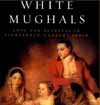 |
==James Achilles Kirkpatrick
(1764-1805), British Resident at the court of the Nizam
of Hyderabad, contrives to marry Begam Khair un-Nisa, a
lady closely connected to the court, and converts to
Islam in the process--all this in the midst of the
conflict with Tipu Sultan (1799-1800). He and other such
"white Mughals" are the subject of a fascinating and
carefully researched account by *William Dalrymple*. |
 |
==Francois Balthasar Solvyns,
a Belgian, comes to Calcutta in 1790, hoping to succeed
as a coach-painter. Instead, over the next fourteen
years he creates a remarkable body of over 600 colored
etchings "descriptive of the Manners, Customs and
Dresses of the Hindoos" of Calcutta. Thanks to the *Univ. of Texas*, these are now
available online. (*Routes*) |
|
|























